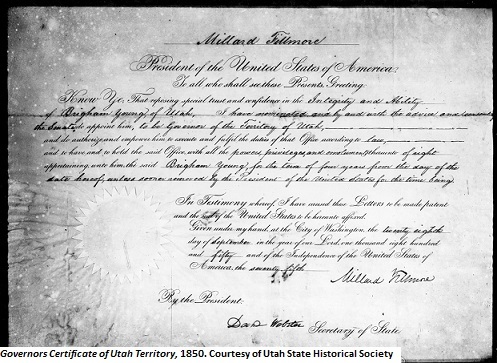Dublin Core
Title
Description
Learn why the US Congress had a problem in 1850, and how its solution led to the creation, 160 years ago this month, of a place called Utah.
The lands of the American Southwest, an area now covering California, Wyoming, Colorado, New Mexico, Arizona, Nevada, and Utah, were ceded to the United States following the end of the Mexican-American War in 1848. The problem confronting the US, however, was whether the new lands should become slave states or free. The union of the nation depended on keeping a balance, and for two years, Congress wrestled with the question.
In the absence of any decision, people living in those areas began to organize governing institutions of their own. Mormon leader Brigham Young established an independent government called Deseret, which stretched from the Rocky Mountains to the sea, and petitioned for statehood as a way to secure local independence.
Finally, members of Congress made a deal called the Compromise of 1850, wherein California was admitted to the Union as a free state, while the remaining lands became the New Mexico and Utah Territories, where people were allowed to decide the slavery issue for themselves. The compromise resolved the immediate crisis, but only delayed the question of slavery in western lands.
Congress also refused to grant statehood to Deseret because the region lacked the required number of eligible voters. Moreover, they objected to the huge size of the proposed state. When selecting a name for the new territory, Congressional support was strong for the name Utah, after the indigenous Ute tribe. Mormons resisted naming the territory after a people they scorned and feared, but the name prevailed.
So, in September 1850, Congress passed a bill organizing the Utah Territory, rejecting the name Deseret and shrinking its presumptuous borders. However, President Millard Fillmore's politically astute selection of Brigham Young as governor made territorial status easier for the Mormons to accept. In gratitude, they named their new territorial capital and its surrounding county after him. Utah would wait another 46 years for statehood.
Creator
Source
_______________
See Will Bagley, “150 Years Ago Today, Utah Became Territory and Was Handed Its Name,” Salt Lake Tribune, 9/9/2000, p A1; Edward Leo Lyman, “Statehood for Utah,” and Richard D. Poll, “Deseret,” Utah History Encyclopedia, accessed http://www.media.utah.edu/UHE/; Dale L. Morgan, The State of Deseret (1987); Peter Crawley, The Constitution of the State of the State of Deseret (1892); Edward Leo Lyman, Political Deliverance: The Mormon Quest for Utah Statehood (1986); Henry J. Wolfinger, "A Reexamination of the Woodruff Manifesto in Light of Utah Constitutional History," Utah Historical Quarterly 39 (Fall 1971); and Gustive Q. Larson, The Americanization of Utah for Statehood (1971).

